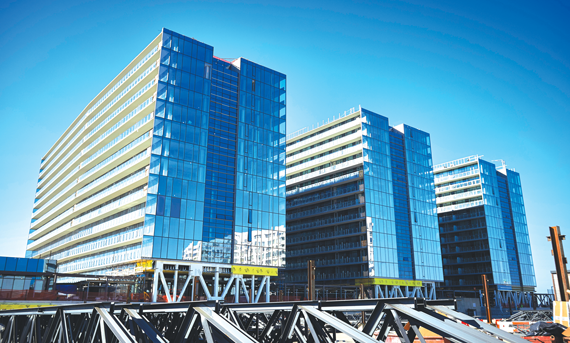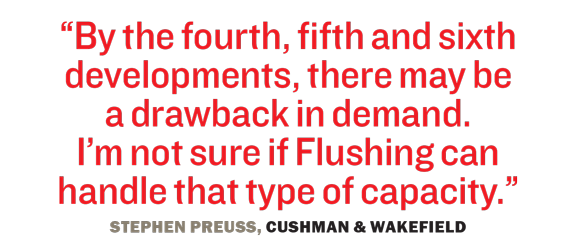Trending
Flushing’s growing pains
With an overtaxed infrastructure and thousands of condos in the pipeline, can the Queens enclave sustain the housing boom?

These days, Flushing is like a teenager undergoing an awkward growth spurt.
Driven largely by a skyrocketing Chinese population, the Queens neighborhood has seen an explosion in luxury condos, retail and office space, and upscale hotels. Since 2010, over 2,600 condominium apartments have hit the market, and between 2,400 and 2,800 more are expected to follow by 2021, according to public-records data compiled by the real estate consultant Nancy Packes. During that same time period, the average price per square foot of a one-bedroom condo in Flushing increased 39 percent to $748 per square foot.
The largest of the megaprojects under development, Onex Real Estate Partners’ Sky View Parc, has set the stage for the neighborhood’s glossy makeover. The three-building condo project, which sits atop a retail mall adjacent to the 7 train line, opened in 2011 with 448 units. The next phase, dubbed Grand at Sky View Parc, is currently under construction and will add three condo towers with 750 units.
Closer to the neighborhood’s main retail drag lies Flushing Commons — a $1 billion, 1.8 million-square-foot office, residential and retail complex developed by F&T Group, along with the Rockefeller Group and AECOM Capital. The project is expected to bring 600 condos to the market by 2021.
Not surprisingly, all the success has fed on itself, spurring plans for even more growth. In September, The Real Deal reported that Queens-based developer Wing-Fung Realty Group, led by Andy Chau, filed plans to build a three-building, 326-unit development complex at Flushing Point Plaza, down the road from Sky View Parc, after he snagged the site from Sam Chang’s McSam Group last year for $44.5 million. And just this past August, Beijing-based developer Xinyuan Real Estate plunked down $66 million for RKO Keith’s Theater, a landmark movie palace it plans to convert into 269 apartments.
But the rapid expansion has also fueled growing concerns, especially as the overall New York City market slows. Stephen Preuss, a director at Cushman & Wakefield who brokered the RKO deal, said he can understand the demand for the first several thousand units. When Grand at Sky View Parc’s second tower, Grand Two, launched sales in the fall of 2015, $85 million in contracts sold in the first week, Onex reported at the time. The average starting price for a condo at Sky View’s trio of Grand buildings ranges from $1,029 to $1,210 per square foot.
But it’s been roughly a year since the market was tested in this way — while there’s plenty in the pipeline, the majority of new condo units aren’t set to be released until 2019, at what may be a very different point in the cycle.
“By the fourth, fifth and sixth developments, there may be a drawback in demand,” Preuss said, adding: “I’m not sure if Flushing can handle that type of capacity.”
 Meanwhile, there are signs that land prices have become overheated. David Brickman, a director at Onex, said his firm wants to do more development in Flushing, but he’s waiting for the market to settle. “Land prices are a little bit inflated right now,” he said. “Developers looked at our success and have tried to price that into their properties.”
Meanwhile, there are signs that land prices have become overheated. David Brickman, a director at Onex, said his firm wants to do more development in Flushing, but he’s waiting for the market to settle. “Land prices are a little bit inflated right now,” he said. “Developers looked at our success and have tried to price that into their properties.”
Among the big players who seem to have cooled on the Flushing market is hotelier Sam Chang. Back in September 2015, the McSam Hotel Group CEO told TRD that the Flushing market was “hot.” He was planning to build condo towers as well as two hotels in the neighborhood. But the following month, he flipped the development site to Wing-Fung’s Chau. “I don’t believe in this market,” Chang said in a Commercial Observer story at the time.
Bursting at the seams
Even to passing observers, the strains on the neighborhood’s infrastructure have become obvious. While both the MTA and LIRR serve the area, the streets around Flushing’s Main Street are one of the most congested in terms of vehicle and foot traffic. For motorists and business owners, the availability and price of parking is a big concern. On any given weekend, traffic slows to a crawl as frustrated drivers circle crowded parking lots.
“It’s like putting a size 7 foot in a size 6 shoe,” said Dian Yu, president of Flushing’s Business Improvement District. He fretted that major traffic congestion will discourage the very consumers new developments are aiming to woo.
George Xu, CEO of Century Development Group, which is building a 14-story mixed-use project on Farrington Street and 35th Avenue, noted that his friends have begun parking north of Northern Boulevard, the thoroughfare that marks the northern edge of Downtown Flushing, just to avoid the congestion. Xu himself confessed, “I don’t like to drive there anymore.”
The city has also acknowledged the overcrowding. The de Blasio administration recently nixed a massive rezoning plan for Flushing West, an industrial zone between the 7 subway terminal and Flushing Creek that the mayor had targeted for affordable housing. The decision came after City Councilman Peter Koo, who represents the area, wrote a letter to City Hall, saying: “Concerns arose about the sustainability of nearly every major category in the urban planning spectrum — affordable housing, public transportation, traffic, school capacity, small business and residential displacement, and environmental remediation.”
Joseph Sweeney, a chairperson on Community Board 7, which includes Flushing, said he researched the rezoning plan and agreed that it wasn’t sustainable. “We were not ready for it,” he said.
Sweeney, who is not against development per se, said he is worried about taxing the city’s sewage system and the already overcrowded subway platforms, sidewalks and streets. “If these particular problems are not addressed, people are going to leave,” he said. “I would love to see the city invest money in the infrastructure to alleviate the problem.”
Aside from transit and sewage, another pressing issue is whether the development of new schools, parks and community spaces will keep pace with the growing population. A key attraction for high-net Chinese immigrants are whether there are good schools in the district, according to Wendy Cai-Lee, of East West Bank, which has been working with the Chinese community. A 2015 analysis by the city’s Independent Budget Office found that District 25, which includes Flushing, was among the most overcrowded in the city. The district had a deficit of 5,201 school seats in 2014, with 2,284 in the pipeline through 2024.
“This is a market that’s very specific” Cai-Lee said. “From a developer standpoint, you have to know the Chinese-American market.”
A self-sustaining market
Brokers and developers see burdened infrastructure as part of the bargain of fast growth. Xu, for one, suggested that the challenge was surmountable, saying: “Flushing will find its way.”
Those who believe that demand will keep up with supply point to the fast-swelling numbers of potential Chinese buyers. Between 2000 and 2010, U.S. Census data show the Asian population in Flushing grew 37 percent to 50,000, while the Chinese component nearly doubled, to 34,680.
“The Asian population wants to stay here for the language and the community,” Xu said. “It’s not just new immigrants.” His brother Chris Xu, of United Construction & Development Group, is developing a 14-story building next door and is in contract to buy a 3.7-acre lot for over $100 million.
Outsiders are also coming. Onex’s Brickman noted that less than 30 percent of the buyers of units at Sky View Parc’s second phase hail from Flushing ZIP codes. “We’re pulling from a lot of the suburban markets,” he said. “We have millennials and empty nesters selling their houses in Long Island and Westchester and moving back to the city.”
Richard Siu, chief investment officer of F&T Group, agreed that the area is attracting a wider range of buyers. “You see a lot of people trading in a house and moving to a more urban environment. They’re attracted to Flushing for its access to Manhattan, and the neighborhood’s vibrant mix of food, entertainment and shopping,” he said.
In general, Flushing developers said foreign Chinese buyers, which have displayed a huge appetite for U.S. real estate, were not the primary drivers in the market. But that could change, however, as more Chinese seek to invest their savings abroad amid economic turmoil in China and as they seek value over luxury.
Ultimately, experts argue that Flushing’s revitalization is self-sustaining. By sending ripples of prosperity outward, it gives new life to businesses eastward toward East Flushing and Long Island, as well as westward to Flushing Creek and southward to Corona. That in turn continues to feed ever more shoppers and visitors to Downtown Flushing, which serves as a Chinatown that rivals the one in Manhattan.
“It’s a 24-7 city within New York,” said Brickman. “It has everything.”




